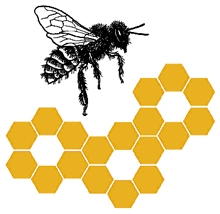Different formulations of the same insecticide often vary considerably in their toxicity to bees. Granular insecticides generally are not hazardous to honey bees. Dust formulations (seldom used today on commercial field crops) are typically more hazardous than emulsifiable concentrates because they adhere to the bee’s body hairs and are carried back to the beehive. Wettable powder and flowable formulations essentially dry to a dust-like form which foragers can carry to the hives. Likewise, microencapsulated insecticides can be collected by foragers …
Neonicotinoid Seed Treatments and Honey Bee Health

A National Research and Extension Initiative to Reverse Pollinator Decline
This is part of an ongoing series of updates from the Managed Pollinator CAP. Additional installments can be found at the:
More information about the CAP can be found at:
by Greg Hunt and Christian Krupke, Purdue University
CAP Updates: 28
- Jointly published in the American Bee
The First Two Years of the Stationary Hive Project: Abiotic Site Effects

A National Research and Extension Initiative to Reverse Pollinator Decline
This is part of an ongoing series of updates from the Managed Pollinator CAP. Additional installments can be found at the:
More information about the CAP can be found at:
by Francis Drummond1; Kate Aronstein2; Judy Chen4; James Ellis3; Jay Evans4; Nancy Ostiguy5; Walter Sheppard
…Protecting Honey Bees During Corn and Soybean Planting Season
 Field crops planting season is underway in the Midwest. Most of the annual crop acreage planted in North America this year will use neonicotinoid treated seed. Neonicotinoids are extremely toxic to honey bees, and recent research has suggested that honey bees that forage near these types of plantings may be at risk. The risk is greatest during the period while crops are being planted. Dr. Christian Krupke and Dr. Greg Hunt (Purdue Extension Entomology) will present an overview of the …
Field crops planting season is underway in the Midwest. Most of the annual crop acreage planted in North America this year will use neonicotinoid treated seed. Neonicotinoids are extremely toxic to honey bees, and recent research has suggested that honey bees that forage near these types of plantings may be at risk. The risk is greatest during the period while crops are being planted. Dr. Christian Krupke and Dr. Greg Hunt (Purdue Extension Entomology) will present an overview of the …
The Managed Pollinator CAP after Three Years: Highlights and Emerging Trends

A National Research and Extension Initiative to Reverse Pollinator Decline
This is part of an ongoing series of updates from the Managed Pollinator CAP. Additional installments can be found at the:
More information about the CAP can be found at:

Keith S. Delaplane, Professor and CAP Director, University of Georgia
by Keith S. Delaplane, Professor and CAP Director, University of Georgia
CAP Updates: 23
- Jointly published in
Nest Location in Bumble Bees: Effect of Landscapes and Insecticides

A National Research and Extension Initiative to Reverse Pollinator Decline
This is part of an ongoing series of updates from the Managed Pollinator CAP. Additional installments can be found at the:
More information about the CAP can be found at:

Anne L. Averill, University of Massachusetts/Amherst
by Anne L. Averill, University of Massachusetts/Amherst
CAP Updates: 22
Jointly published in the American Bee Journal and in Bee Culture…
Broodmapper: Honey Bee Development and Citizen Science

Figure 1: A honey bee emerging from a capped cell. Above, left of the emerging bee is a capped cell with a developing pupa unseen, underneath the cap. Above, far right of the emerging bee is a cell with a honey bee egg.

Figure 2: A screenshot from Broodmapper.com with scored cells.
Honey bee development
Honey bees develop from eggs to adults in the cells of honey …
Miticide and Fungicide Interactions

A National Research and Extension Initiative to Reverse Pollinator Decline
This is part of an ongoing series of updates from the Managed Pollinator CAP. Additional installments can be found at the:
More information about the CAP can be found at:
CAP Updates: 20
by Reed M. Johnson, University of Nebraska-Lincoln
Jointly published in the American Bee Journal and in Bee Culture, October 2011.
There is no …
Assessing the Risks of Honey Bee Exposure to Pesticides

A National Research and Extension Initiative to Reverse Pollinator Decline
This is part of an ongoing series of updates from the Managed Pollinator CAP. Additional installments can be found at the:
More information about the CAP can be found at:


CAP Updates: 17
Marion Ellis and Bethany Teeters, University of Nebraska
- Jointly published in the American Bee Journal and in Bee Culture, July 2011
Abiotic stress …
Pesticides and Their Involvement in Colony Collapse Disorder

A National Research and Extension Initiative to Reverse Pollinator Decline
This is part of an ongoing series of updates from the Managed Pollinator CAP. Additional installments can be found at the:
More information about the CAP can be found at:
CAP Updates: 18
by JIM FRAZIER, CHRIS MULLIN, MARYANN FRAZIER and SARA ASHCRAFT Department of Entomology; Penn State University, 501 ASI Building, University Park, PA
Jointly published …


